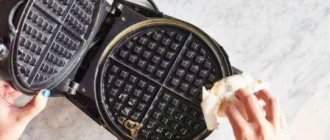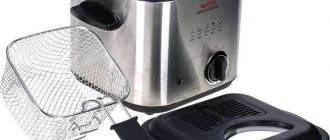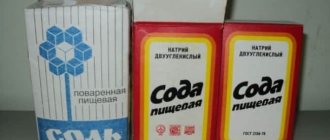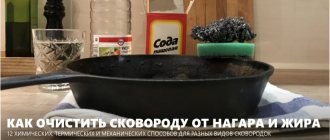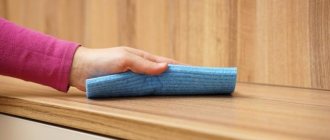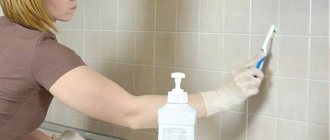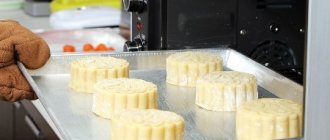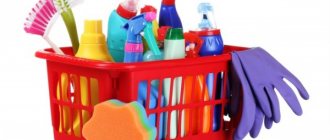It is not so easy to quickly and thoroughly remove traces of grease from a kitchen apron made of tiles or plastic. Aggressive products can ruin the texture of the surface, and household chemicals that are too mild will not give the desired result. The most difficult area to work with is the area above the stove; in this part of the kitchen the fat is dense, melted, and rancid.
If you wish, you can, of course, remove plaque, but it is better to prevent the formation of a multi-layer formation and regularly treat the kitchen apron with mild detergents with degreasing components, for example, dishwashing liquid.
How to properly wash MDF panels
The most dirty area in the kitchen is the countertop.
Therefore, general cleaning once every three weeks is not enough here. Only daily care will keep this surface clean. If the countertop is made of natural stone, use non-aggressive means, or even better, folk ones. For tools, choose microfiber. For complex stains on the countertop, there is the following method. For two tablespoons of apple cider vinegar, you will need a couple of drops of each of the aromatic oils: lavender, tea tree and geranium. Apply the product to the sponge and rub the dirt. In addition to the visible result, harmful bacteria and unpleasant odors also disappear.
With an artificial countertop everything is much simpler. It is acceptable to use most products, even abrasive ones. As for chemicals, “Sif” will do an excellent job; among improvised ones, soda and citric acid. How to clean a kitchen apron and walls?
You can wash plastic panels from grease using any of the methods described above for this material. If tiles are laid, proceed as follows.
1 option
- Mix 4 tbsp. water and 1 tbsp. vinegar.
- Apply the solution for 10-15 minutes.
- Rinse off with a wet cloth and wipe dry.
Option 2
- Dilute 1 tsp. salt in a liter of water.
- Use the resulting solution to remove grease from the tiles.
- Wipe with a damp and then dry cloth.
You can wash the wallpaper in the kitchen with a rubberized cloth. Afterwards, carefully go through with a vacuum cleaner.
It is better to wash linoleum daily with plain water. But if this is not possible, then you can wash the linoleum weekly using a soap solution. In case of severe contamination, add vodka (half a glass of alcohol per 1 liter of water).
But light linoleum can be washed using water from boiled potatoes. Just let it cool.
The tiled floor in the kitchen can be easily washed from dried grease with water and ammonia (per 1 liter - 3 tablespoons of alcohol). To make the tiles shine, you can add a couple of teaspoons of glass cleaner to the solution. And to clean the tile joints, you can use an old toothbrush with washing powder.
In the time of our grandmothers, there were not so many aggressive household chemicals on store shelves. But the problem with stains on the kitchen apron existed even then, and it was solved with simple and affordable means at hand.
- Vinegar solution. Dilute vinegar with boiled water at room temperature (or slightly higher) and rub the dirty area. If this doesn't help, try increasing the concentration of vinegar or warming it up slightly.
- Lemon acid. This product is great for stone or white tile backsplashes. It not only helps remove grease, but also whitens the surface and also has an antibacterial effect. It is enough to wet the contaminated areas with warm water, and then apply dry citric acid to it and rub. An even more effective way: treat the apron with a paste of acid granules and a small amount of water.
- Soap solution. To make this simple but effective remedy, simply grate a little soap and then mix the shavings with warm water. Soak a sponge in the resulting thick mixture, and then rub it over the most problematic areas.
The result will be noticeable already during the next general cleaning, when you won’t have to spend as much time and effort cleaning this area as before.
Many housewives cannot tolerate chemicals. And cleaning for them using chemical cleaning products turns into punishment. You can avoid this if you use our grandmothers’ recipes:
- Vinegar solution.
- Water with a small amount of ammonia.
- Rub a small amount of soda onto the stain and add a little vinegar to it. The reaction of baking soda and vinegar will make cleaning easier.
- Lemon – Rub a slice of lemon onto the tiles and leave for half an hour.
If the stains are very old and such methods will not help to deal with them quickly, use a steam cleaner.
Another problem is dirty joints and seams between tiles. All of the above cleaning products and folk recipes will help you deal with dirt in these places. The only difference when cleaning is that if we wash the tiles with soft rags, then it is better to use a brush to clean the joints and seams. An old toothbrush is ideal.
To prevent the joints from becoming distressing, and to prevent fungus and mold from developing on them in the near future, treat them with vinegar. And don't forget to use gloves while cleaning! This will protect the delicate skin of your hands from the negative effects of chemicals.
Every housewife knows that keeping the kitchen perfectly clean is very difficult. They cook here every day, and therefore crumbs, various contaminants, greasy stains, soot and soot cannot be avoided. Therefore, you should always have cleaning and detergents, as well as sponges, rags and brushes on hand.
A tidy kitchen means not only washed dishes, but also sparkling clean floors, cabinets, walls, stove, refrigerator, various panels and surfaces. Every kitchen area needs to be cleaned properly. You need to know what product you can use to clean plastic panels in the kitchen from grease without damaging the coating, and what cleaning method is best for removing various contaminants.
Secrets, useful recommendations and the most effective cleaning methods - all this is in our article with video.
Plastic surfaces in a given room may have window frames, slopes, window sills, door panels and elements of furniture facades, and sometimes walls. It is not difficult to remove fat from them. A standard dishwashing detergent, liquid laundry soap, or a special store-bought spray will help. Household chemicals can be replaced with folk remedies - proven methods, proven in practice by many housewives, can easily cope with dirt and grease in the kitchen.
More details about each method and tool below.
To remove grease using dishwashing gel, you must:
- Fill a basin or bowl with warm running water.
- Pour in a little soap solution. Stir until foam forms.
- Soak a sponge in the liquid and rub the greasy stains. Leave them to soak for 5 minutes.
- Using circular movements, with little effort, scrub away dirt.
- Wash the top with a damp cloth or napkin and wipe dry so that there are no streaks left and the shine is further enhanced.
Also use liquid laundry soap.
Important: you should absolutely not rub the plastic too hard or use a metal brush. So it can be damaged and scratched.
From store-bought sprays, it is recommended to choose glass cleaners that contain alcohol. It perfectly eats away old fat. Anti-grease spray can easily cope with this task; you can also use Sif cream. For light surfaces, take the “Dosya” product, it gives 100 percent results. Please note that liquid gel is not suitable for colored panels.
Another option for effective cleaning is a melamine sponge, which is widely popular among housewives.
To wash plastic from grease in the kitchen, you can prepare a homemade solution based on vinegar or vodka or alcohol. We should not forget about commonly available soda, which is diluted to a paste and does an excellent job of removing dried stains and grease.
This finishing is most often done around the slab. Food stains and grease leave marks on the surface every day. However, these coatings are unpretentious to such conditions. It will be much easier to remove dirt if you don't let it dry.
Using household chemicals from the store can quickly and easily remove grease from tiles. But not all solutions and sprays are suitable for this type of coating.
Important: do not rub glossy ceramic surfaces with products containing abrasive particles. They are often recommended because powders do an excellent job of removing dirt, but they can also damage the surface.
Of the available options, it is better to choose a gel or spray. In general, any liquid foundation. You can learn how to clean grease from kitchen tiles with a specific product from the instructions on the label.
Fresh stains can also be washed with a regular solution of dishwashing detergent. It is recommended to clean dried and old ones from fat with special compounds.
- Apply the solution to the surface.
- Leave for a few minutes.
- Wipe off dirt with a sponge.
- If necessary, the procedure can be repeated.
- To avoid streaks, wipe the surface dry with a clean towel.
We suggest you read How to clean natural or artificial suede from dirt at home
Tip: do not use metal brushes. Better use a glass scraper.
Folk remedies also effectively deal with dirt. In particular, lemon can be rubbed onto dirty areas. The acid will soften the fatty layer. Or use soda slurry. Apply it to problem areas, then moisten with a few drops of vinegar. Wash away dirt with a sponge. Remove any residue with a damp cloth.
Use hard, elastic sponges to clean this area. In this case, an ordinary rag will be ineffective and will not cope with the task.
Sprays, gels, and powders from the store often clean tiles or tiles in the kitchen well and thoroughly. For best results, it is recommended to warm up liquid products slightly before use. This way they will break down fat more efficiently.
If one composition does not help, use the next one. But do not apply several solutions at the same time. The reaction between them can damage the surface.
It is better to steam old stains from grease first. Thanks to heat treatment, complex stains will disappear faster and more efficiently.
Advice: when cleaning the 'apron' with household chemicals, it is better to open the window and do the cleaning in a well-ventilated area. This way you can avoid allergic reactions and tearing.
Folk remedies for cleaning tiles, stone or glossy surfaces are universal and budget-friendly. In addition, their effectiveness has been proven for many years. You can remove fat from the “apron”, for example, using warm rice water. However, it is worth paying attention that the treated areas will need to be wiped with clean water afterwards, otherwise white stains will remain.
Citric acid perfectly degreases surfaces. It can be used in several ways:
- Apply dry to stains previously moistened with warm water.
- Prepare the powder. To do this, dilute the acid to a paste with several tablespoons of warm boiled water.
Both methods are very effective.
Housewives who have MDF facades or glossy panels are often interested in how to properly care for them. Furniture of this type is difficult to clean. It can be washed with any cleaning agents and detergents, except those containing chlorine or abrasives. It is recommended to use kitchen sponges to scrub stains.
Lemon
Citric acid or lemon juice will help remove grease from the apron. If citric acid is chosen for processing, it must be diluted in water. You will need to squeeze the lemon first and, without diluting the juice with water, treat the surface. Use a spray bottle to apply to the apron. Leave the product for 15 minutes, then rub with a brush and rinse with water. If necessary, repeat processing.
lemon
Necessary equipment
Before you start cleaning your kitchen from dirt and grease, you should be thoroughly prepared. Gather the necessary materials and tools:
- Detergent or ingredients to make your own. It is better not to use harsh abrasive substances, especially for wooden kitchens.
- Rags and sponges. Soft ones are better: microfiber or flannel are perfect for cleaning furniture from grease. Don't use the old ones - they will only make things worse.
- Rubber gloves (thick).
- Apron.
- Unnecessary toothbrush (soft).
- In some cases, a knife, the blade of which can be wrapped in a cloth, will save the situation so as not to scratch the surface being cleaned.
The nuances of using professional tools
Despite the active promotion of the use of industrial products to restore order in the kitchen, when dealing with numerous layers of fat, they do not perform well. Soft compounds only spread dirt over the surface, while aggressive ones cause scratches. In addition, such chemicals most often turn out to be specialized rather than universal. By using them to clean plastic, you can achieve an excellent result that will not be visible at all on tiles or stones.
Before using the selected product, you must carefully read the instructions on the packaging. This allows not only to obtain optimal results, but also to prevent damage to the material. And if the packaging says that the composition is not suitable for cleaning plastic, you shouldn’t take the risk.
Effective and affordable folk remedies
Before you run to the store for expensive cleaning products, try first washing the kitchen facades of grease using proven methods that have been proven over the years. They have quite a lot of advantages:
- firstly, every housewife, as a rule, has the ingredients;
- secondly, they are very easy to use;
- thirdly, it is environmentally friendly.
Baking soda
Excellent for removing grease from kitchen utensils. The method is suitable for almost any surface. Avoid only varnished and glossy ones, on which soda can leave scratches. Any of the options is recommended to be used every three weeks.
The compositions with which our grandmothers tried to wash kitchen aprons have not lost their relevance today. They are easy to use and allow you to achieve the desired results in a short time:
- Rice water. Despite its mild action, the liquid copes with fresh stains without any problems, especially if used warm. After removing the grease, the surface should be thoroughly washed with clean water so that no whitish stains remain on it.
- Mustard. We take a damp sponge, dip it in dry mustard powder, which we apply to the problem area with blotting movements and leave for a few minutes. After this, the area must be cleaned with the same sponge. If the contamination is old, then it is better to use a concentrated solution rather than a dry product. In this case, dilute the mustard with warm (not hot!) water.
- Lemon acid. Ideal product for white tiles or stone, but can also be used on plastic. Using the composition, you can not only wash away dirt, but also disinfect and whiten the surface. Wet the oily area with warm water, and then apply the dry composition to it. We wait a few minutes and rub the surface until the desired result is achieved. A paste made from citric acid and a small amount of warm water is even more effective in the fight against fat.
- Vinegar solution. We dilute table vinegar with warm boiled water and use it to rub the problem area. If the desired result cannot be achieved, we use a composition of higher concentration, preheated to a very warm state.
- Soap. Even a soap solution can give the desired effect if used correctly. Take some soap shavings and dilute it with warm water until you get a thick soap composition. We moisten a sponge in it and use it to scrub problem areas.
- Clay. Not quite an ordinary product, but very effective in the fight against fat. Take the dry powder and sift it through a sieve. We dilute the mixture with vinegar, you should get a homogeneous paste. We apply it to an apron covered with grease and wipe off the dirt. After this, be sure to repeatedly wash the treated area and dry it with towels. This manipulation allows you to wash off traces of drips, rust, and scale along with the grease.
- Baking soda. A fairly mild product that cannot damage even a plastic surface. In this case, it is again recommended to prepare a homogeneous paste from the component. It is applied in an even layer to the fat, cleaning begins after 5 minutes. During manipulation, the sponge should be regularly moistened with warm water to enhance the effect and speed up the process.
Another undeniable advantage of natural household chemicals is the fact that it is universal. Complex and one-component compositions are suitable for cleaning plastic, tiles and stone of any degree of contamination.
Some housewives do not use chemical detergents to clean kitchen surfaces, so they use traditional methods. Mixtures that have been tested over the years sometimes work better than expensive liquids. Using the tools listed below, you can easily find the answer to the question of how to remove grease from kitchen furniture.
3.1 Recipe No. 1
- It is suitable for any type of surface, since the oil is easily absorbed into the wood and hides its unevenness, forming a protective film that in the future prevents fat from penetrating into the texture of the material:
- Mix vegetable oil and baking soda in approximately equal proportions.
- Apply them to dirty areas with a soft cloth.
- After about half an hour, simply remove any clumps of fat.
If after the first attempt there are still traces on the surface, you need to repeat the procedure one or more times, depending on the complexity of the situation.
3.2 Recipe No. 2
- Water must be mixed with baking powder.
- Apply the resulting paste to grease stains.
- Leave the mixture for about half an hour, then rinse with warm, clean water.
3.3 Recipe No. 3
- Apple cider vinegar (which does not have a strong odor like plain cider vinegar) should be added to a glass of water.
- Dampen a soft cloth and wipe the surface where the grease has accumulated. This cleaning will make it possible to add shine to any glossy surface.
3.4 Recipe No. 4
- Soak a sponge in alcohol or vodka and rub the area with the grease stain.
- If you can’t solve the problem, wet the stain with alcohol and leave for 30 minutes.
- After this, you need to wash off the substance using water and a few drops of essential oil.
When cleaning wooden surfaces, essential oil will not only help you cope with bacteria, but will also give the facade shine and a pleasant smell.
3.5 Recipe No. 5
- Take 1 liter of water, 15 mg of citric acid and 2 drops of detergent.
- Soak a cloth in the liquid and apply it to the greasy surface.
- Leave for half an hour, then rinse with water and wipe dry.
3.6 Recipe No. 6
- Take 200 ml of vodka, 200 ml of vinegar and half a teaspoon of essential orange oil. Spray the prepared product onto the surface using a spray bottle.
- After 20 minutes, rinse off the mixture and wipe the surface.
We suggest you familiarize yourself with How to wash roller blinds: dry and wet cleaning, how to remove grease
This mixture is perfect for removing plaque from tiles and ceramic surfaces. You can use it to combat grease on your stove or any type of plumbing fixture.
3.7 Recipe No. 7
For this you will need lemon. Use a slice of fruit to wipe the furniture so that the juice drips down. After 10 minutes, the surface should be wiped with a cloth pre-moistened with water. After treatment, you can also clean the set from stains using a paper towel.
3.8 Recipe No. 8
Clay diluted with vinegar may be suitable for cleaning wooden furniture. The resulting slurry should be applied to the doors and left until it is completely dry. After this, you can wash off the mixture with water.
3.9 Useful tips
- Granite and marble surfaces cannot be washed with chemicals, so it is better to use simple laundry soap.
- Furniture should always be dried after cleaning. Moisture remaining on the surface can be absorbed or leave stains on it, which will then be very difficult to deal with.
- You can also get rid of small cracks on the surface of furniture. To do this, it will be enough to rub them with a walnut. The oily substance will quickly penetrate the scratches, filling them.
- To clean a kitchen set made of laminated chipboard, you can use a ceramic scraper. If you decide to clean your refrigerator, a wooden or plastic kitchen spatula is perfect for this.
- Before you start removing old fat from a vertical surface, you need to lay down paper. Removed dirt will roll off and stick to it.
- Polish applied after cleaning the furniture will significantly slow down the process of contamination in the future.
Rules for cleaning a kitchen apron that increase the efficiency of the approach
The effectiveness of the products used will increase many times over, and the result will be obtained with the least effort if you follow the following rules for processing an apron in the kitchen:
- The work will go faster if you first slightly warm up the selected product, especially if it is prepared independently from natural ingredients. If you need to clean a plastic surface, you first need to make sure that the composition will not remove part of the material in addition to grease.
Tip: Cleaning an apron in the kitchen is not the most pleasant thing due to the variety of strong aromas. To avoid suffering from watery eyes, sneezing and other signs of irritation of the mucous membranes, you must first ventilate the room and do not close the window during manipulations. A hood, no matter how powerful it is, will not cope with such a strong smell.
- The easiest way to wash off grease is with a sponge. Regular rags will be ineffective, metal mesh will damage the surface. The sponge also should not be dense; even a regular dishwashing utensil will cope with the task without any problems.
- An apron covered with a thick layer of fat is recommended to be steamed first. If it is tile, you can place an oblong container of boiling water at the base of the masonry for a few minutes. It is better to treat plastic surfaces locally, using the spout of a kettle with hot water.
- If the chosen product does not help and you need to use another product, you first need to wash the material from the remnants of the previous chemical, otherwise reactions may begin that will lead to damage to the surface.
- It is strictly forbidden to mix several folk remedies or household chemical products at once in order to increase their effectiveness. A positive result is not guaranteed, and it is quite possible to permanently ruin an apron in the kitchen.
We recommend: How and with what can you clean an old samovar until it shines?
Folk remedies are considered universal; they can be used to treat surfaces made of plastic, tile and stone. Household chemicals can be highly specialized, so you should carefully read the label before using them.
How to clean grease from plastic panels in the kitchen
Don't even try to wipe away old oil stains and food residues with a regular rag. As a rule, only a special elastic sponge with a hard surface can clean this area. But even it shows the best results only in tandem with household chemicals: gels, sprays and powders for tiles and tiles.
If one type of gel or powder does not help, you should not mix several compounds on the surface at once. Their components may be incompatible with each other, and the resulting reaction is quite capable of irreversibly damaging the surface. It’s better to try steaming the apron to melt the layer of fat, making it softer and more pliable for cleaning.
Try warming it up slightly and only then applying it to the problem area. However, before doing this, carefully read the instructions on the package, as some household chemicals can release harmful substances when heated.
This universal product, firstly, degreases, secondly, does not leave scratches, and thirdly, does not spoil the color/pattern.
How to use for oily plaque:
- Add the gel to a small amount of water and whisk until foam forms.
- To make the effect more effective, you can add a little peroxide (but this is only for light-colored surfaces, since peroxide washes off the paint).
- Apply the resulting liquid to the desired areas and leave for a couple of minutes.
- Wipe with a dry soft cloth.
After cleaning, it is recommended to wipe or spray a fiberboard or natural wooden surface with a polish, which tends to cover it with a special protective layer that prevents the rapid accumulation of dust.
It is easy to wash glossy or wooden surfaces using an alcohol solution in a 1:1 ratio with water. You can also make a “powerful” homemade composition. You just need to mix lemon zest or juice with vinegar and a few drops of alcohol. This will be a very effective fat remover.
In conclusion, it should be noted that housewives often face difficulties in cleaning the kitchen. To prevent cleaning kitchen surfaces from becoming an overwhelming task, wash this area regularly, preventing stains and dirt from drying out and turning into multi-layered formations.
- Using a solvent: moisten a foam sponge in this product, carefully rub this substance into the grease stains for 4-5 minutes. After which the treated area should be thoroughly wiped with a dry towel.
- Using a natural remedy in the form of citric acid, which should be diluted in the amount of two tablespoons in 200 ml of water and, using a cotton pad, wash the affected areas of the door surface for 3-4 minutes.
- Using baking soda: dilute 3 tablespoons of this product in a glass of water and remove all dirt with a cloth soaked in the resulting mixture, then wipe dry all treated areas.
- To use detergent: dilute 3 tablespoons of dishwashing detergent in half a glass of water and lather thoroughly. Then apply the resulting foam to the greasy stains and leave it all for 4-5 minutes. Then rinse the panel with a cloth with clean water and wipe with a dry towel.
Features of the use of household chemicals when processing tile and plastic products
Few people know, but most industrial household chemicals are unsuitable for treating stubborn stains in the form of grease stains. With their help, you can easily wash off fresh formations, but they will simply spread plaque that has accumulated for several days or even weeks over an even larger area. It is especially dangerous to use them to neutralize problems on the surface of plastic.
It happens that the material has already begun to deteriorate, and fat still covers the surface in places. To avoid making a serious mistake, you should take into account the recommendations on the packaging. If the product needs to be applied to a sponge and treated with a surface, then its composition is obviously too aggressive and must be used to clean stone or tiles. If it is indicated that it is better to distribute the mass over the surface, then it can be used without fear on any materials.
Melamine sponge
The convenience of such a sponge is that when wet, it emits a little foam and acts like a regular office eraser, since it consists of thin, thin rubber fibers. It will rid the kitchen set of grease and soot, as well as various types of stains. It is widely believed that melamine sponge is terribly harmful to health. But it is only dangerous if it gets inside, so you should not wash the insides of kitchen cabinets and dishes with it.
To remove old grease from your kitchen, follow these steps: Wet the miracle sponge in water, squeeze, but do not twist. Scrub the desired surface and then remove any remaining sponge with a dry cloth.
Table vinegar
Regular table vinegar works great for grease on surfaces. In addition, it will also get rid of limescale. The liquid used is not pure, but diluted with water. Spray the resulting solution onto problem surfaces, leave for a few minutes, then wipe with a clean cloth. If necessary, repeat the procedure.
How and what means are best to remove greasy stains from MDF door leaf
The surface of the doors becomes dirty as they are used, and sometimes greasy stains appear. To maintain an aesthetic appearance, owners use various detergents to remove dirt. It is necessary to choose household chemicals based on the type of protective coating. Therefore, it is impossible to remove greasy stains from MDF doors using the same cleaning agents for all panels.
MDF panels, from which modern interior and entrance doors are usually made, often become dirty with the appearance of greasy stains. To maintain the ethics and beauty of such doors, many housewives have to use various improvised means to remove such stains. Moreover, depending on the type of surface coating, use appropriate cleaning agents. In this review, we will take a closer look at how to remove greasy stains from MDF doors, maintaining a natural appearance and without spoiling the surface layer.
- 3 tbsp. Dilute dishwashing detergent in half a glass of warm water. Lather with a sponge. Apply foam to the contaminated surface for 5 minutes. Rinse off with clean water and wipe dry.
- Potatoes help clear stains. Rub half a potato onto the stain until it is covered with the released potato juice. Leave until completely dry. Pour talcum powder or baby powder onto a soft cloth and wipe the surface of the door, removing any remaining starch. Then walk with a clean towel.
After cleaning, treat the entire surface with polish.
Soda
One of the most effective anti-grease products is regular baking soda. It dissolves fat particles, softening it. To wash an apron, you need to apply powder to a damp surface, rub with a cloth, and then rinse with clean water. For easy application, you can prepare a paste of baking soda by mixing it with a small amount of water until it turns into a paste.
soda
Why do greasy stains appear on door coverings?
Basically, the surface becomes oily at the level of the waist and chest. This is due to the fact that people touch this area more often. And since the skin secretes fats along with sweat, upon contact with the surface of the door leaf they end up on the surface of the coating. If you don't wipe the door for a long time, dust and pet hair will settle. Also, stains are formed due to the contact of fatty substances on the surface.
Mostly, grease stains are localized in the area where the door handle is located, since this is where we most often touch with our hands. As you know from biology courses, the skin of our hands tends to secrete sweat-fat segments. When it comes into contact with the surface of the door, those same transparent sweat marks remain on it, onto which over time many dust particles settle and turn into real dirty spots. This problem is especially common among young housewives with small children and pets.
But it is also worth noting that greasy stains on the surface of interior doors appear as a result of contact with a variety of biological or chemical liquid substances that have a certain percentage of fat content.
Preventing the appearance of a thick layer of grease on furniture
Experienced housewives will agree that the most difficult part of cleaning the kitchen is the constant struggle with grease, which remains almost everywhere:
- on tiles;
- on the walls of the stove and refrigerator, if they are located next to the oven;
- in the microwave;
- on the walls of the oven;
- on all facades of kitchen furniture.
Sometimes even a recently appeared stain is almost impossible to remove without detergent. First of all, it is worth remembering that preventing a problem is much easier than solving it. Wet cleaning every day, especially after the cooking process, will protect yourself from unnecessary grueling cleaning of grease. If the contamination is not severe, you can use laundry soap or soda. They will allow you to easily dissolve fat and preserve the skin on your hands.
Recommendations before you start cleaning the kitchen
Before you start cleaning it, you need to find out what materials the kitchen furniture is made from. Wooden kitchens come unpainted and coated with a layer of paint, with plastic facades made of MDF and chipboard, varnished or laminated. But no matter what material is used to prepare kitchen furniture, before you start cleaning it, you should test the detergent to see if it reacts with the surface of the furniture somewhere in an inconspicuous corner. A small-sized surface treated with a cleaning agent is first allowed to dry, then the extent to which its color, shine, and general appearance has changed is determined.
During cooking, fat evaporates along with tiny droplets of water, which deposits a coating on the walls, ceiling, furniture, and other kitchen surfaces. If it is not removed in time, it is absorbed deeper into all surfaces and becomes old. To wash away grease deposits, you need to make a lot of effort. Therefore, general cleaning of all kitchen surfaces must be carried out at least once a year, and preferably twice.
Vinegar with isopropyl alcohol for deep cleaning
A solution of 6 percent vinegar with isopropyl alcohol helps to cope with difficult stains on painted and unpainted wooden surfaces. It is also suitable for removing old grease stains, dirt and grime from worktops, plastic facades of fibreboard and chipboard, varnished surfaces, cladding films and tiles.
To prepare the solution, take 7 parts of 6 percent vinegar and 1 part of isopropyl alcohol, which can be purchased at stores selling consumables for office equipment, and a couple of drops of liquid detergent. Using a napkin soaked in the solution, wipe all contaminated areas of the furniture. The mixture is then removed with warm water, and the surface of the cabinets is rubbed with polish or, in the case of wood, wax. This, for some time, will protect the surface of the kitchen furniture from repeated contamination and moisture penetration.
Cleaning kitchen surfaces with different coatings
Kitchen furniture made from natural wood requires special delicacy. For cleaning, you cannot use household chemicals, which are based on alkali, which copes well with grease and other contaminants, but corrodes wood. Folk remedies containing peroxide, ammonia, and citric acid are also not suitable for cleansing it.
For kitchens made of natural wood, special products with a neutral pH are more suitable. A soap solution and liquids intended for caring for dishes, diluted with water in a ratio of 1 to 20, wash off grease and dirt well from wooden surfaces. To apply the composition to the surface, it is most convenient to use a spray bottle. In order not to harm the wood, movements should be directed along the grain.
Before applying cleaning products, the surface is moistened with plain water using the same spray bottle. This speeds up the reaction and makes cleansing easier. If you decide to moisten with a cloth, you must wring it out well so that excess moisture does not harm the wooden surfaces. Having finished cleaning, all surfaces must be treated with polish, a protective layer of oil or wax.
How can you clean the wooden surface of a kitchen set?
Add 15 grams of citric acid and a few drops of dishwashing liquid to a liter of water. Soak a soft cloth in this solution and treat areas where fat accumulates. Wait 30 minutes and wash the furniture with warm water. Wipe everything with a dry cloth.
Interesting materials:
How does chemistry work in FIFA 21? How does a central bank work? How does a water tower work? How does the exhaust work? How do electric lighters work? How do contact expansion thermometers work? How do museums work during the New Year holidays? How do solar garden lights work? How do sociologists work? How did the first telegraph work?
How to remove grease without damaging the surface of furniture, countertops and stoves
During cooking, a greasy coating forms on the stove and kitchen furniture, which is difficult to remove.
A variety of cleaning products allows you to choose the most suitable one for cleaning cabinets and household appliances. To clean surfaces efficiently without damaging them, you can use:
- Powders PemoLux, Sarma, Chistin . They are convenient for scrubbing away old dirt, but this method of cleaning is aggressive. This increases the risk of damage to furniture surfaces.
- Gels and solutions Cinderella, Sorti, Fairy . They have a soft effect and are suitable for enamel and wooden furniture. At the same time, they are quite effective because they are able to cope with complex stains, carbon deposits, and dried droplets of oil.
- Creams with the addition of special granules, Cif, Sanita pastes. They have universal properties. They can be used for any coating.
- Sprays Mr Muscle, Cillit BANG . Effective when cleaning reflective and glass surfaces. The alcohol present in the composition promotes rapid evaporation of the liquid and prevents streaks.
- Melamine sponges impregnated with chemicals will help with quick cleaning and remove complex stains.
Cleaning compounds are highly effective, but are often dangerous. An incorrectly chosen product can damage the surfaces of furniture or household appliances, cause poisoning or develop an allergic reaction.
The choice of chemistry should be taken with great care. Use only in strict accordance with the instructions. Wear gloves to protect the skin of your hands.

